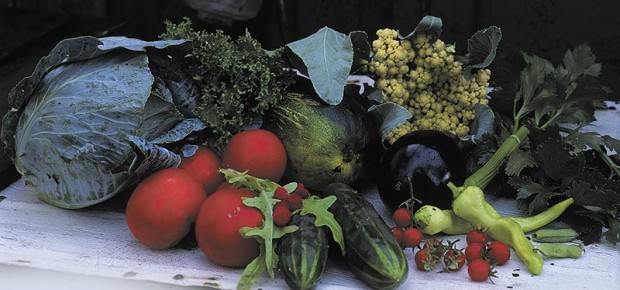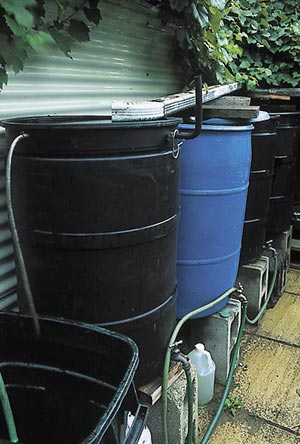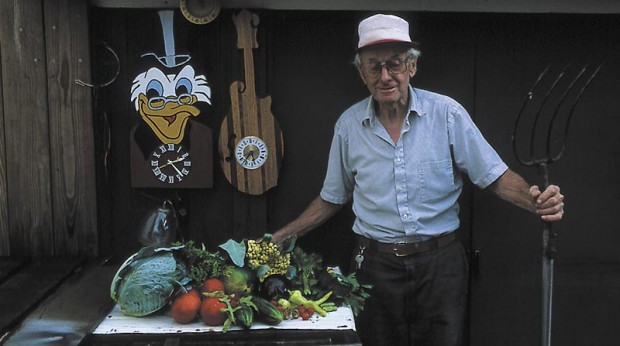
One man’s successful transition of backyard lawn to vegetable garden

Being laid off from your job can certainly change your perspective. In the early 1970’s, trucker Ernie Bergeron received a lay-off notice. Perhaps it was because the future wasn’t looking too bright that a new, dim view of lawn overtook him one day. He recalls standing in his backyard and wondering, “What am I growing all this grass for? I can’t eat grass!”
So he started digging, and planted a vegetable garden. 30 years later, retired but still digging, he improves his techniques every year. The vegetable “bed” now fills every inch of his 750 square foot backyard. It lives up to Bergeron’s description—“my country garden in the city,” partly because it’s completely walled off from the neighbors by lush, bird-planted grape vines and black raspberry bushes that grow along the enclosing fences.
It’s as self-contained as any farm, too. It includes some perennial crops as well as the more standard annual vegetables. There’s a compost area, rainwater collectors and a gravity-fed irrigation system, storage for equipment, plus many practically ingenious and whimsically inspired inventions. A salvaged 55-gallon drum is the main element in an elevated, rotating compost bin, which he turns daily to reap a steady supply of crumbly dark compost. His latest project was once a truck cap. It sits on a cinder block frame now, its black sides absorbing heat and windows oriented to admit light. Bergeron’s fitted it with shelves and is nearly ready to put it to use as a greenhouse.
Vegetable gardening isn’t so popular as flower gardening, but you wonder why, when you stand in Bergeron’s domain and sample the produce. One bite of a fresh-picked cuke or whiff of a warm, ripe pepper and I’m ready to redesign some flower beds to make room for potatoes, corn and beans. It’s like trading one sense for two or three—less visually exciting, perhaps, but heavenly in scent and taste, and much more likely to draw me in to touch and fondle.
And as for the possibilities – the sky’s the limit in this oldest of gardening pursuits. In the 6,000 years that beans have been cultivated, gardeners were not sitting still but selecting and passing on their favorite varieties. Although commercial farmers in North America now restrict themselves to just six potato cultivars, hundreds of types still exist, legacy of ancient New World gardens that provided a range of potato-y flavors from nutty to tart.
It would be a shame, on many levels, to let that legacy pass. European explorers of the 18th century found far better gardens in the Americas than they had known back home. Native Americans grew more species and varieties than most Europeans had ever seen, and in many cases used more advanced techniques. It’s likely that Bergeron, keen on treading lightly on the Earth by growing organically, would have enjoyed comparing notes with those gardeners. They would both know from experience that thorough soil preparation and the plant’s own health are the best defense against any pest.
Bergeron worked hard on his soil preparation at first, but now he works smarter and less hard. “What I found when I first started digging was that this lot was used once for a dumping site. A manufacturing plant that was near here seems to have just dumped truckloads of scraps. It was disgusting. I knew I had to do something to make the soil better.
“Now I cover the whole yard with 10 to 12 inches of leaves in the fall. I wait until it dries in spring then sometime in May I turn the leaves and till them in. Maybe I’ll till them twice if they weren’t all the way dry the first time. Then I level it all and make my raised beds.
“I use string to outline my paths and then dig down, taking soil from the paths, throwing it on the rows and leveling it off. I usually make the rows no more than four feet wide so I can work in them without stepping in them. I can work two feet into the row from either side without stepping on it. It’s important to stay off the rows because the plants grow so much better in loose soil.
“I don’t start seed in the house, usually. The plants are too spindly when I grow from seed in the house. I buy my plants already started, although this year I’ll try out my new greenhouse. Some things I sow directly, of course—beets and carrots, for instance. I make my little rows and start the seed right there.
“I cut some rhubarb and horseradish in May. How do I manage to work around perennials like horseradish and rhubarb when I till in the leaves? I just till right over the horseradish – small pieces come up all over; enough for me to use if I watch for them. The rhubarb grows along the edge with the raspberries and the grape vines on the fence, where I don’t till.
“I don’t do much to the fruit. I prune the raspberries when I have time. I cut the dead canes out and throw a shovel of compost over their roots once in a while. I actually don’t dare go right in with them because I’d be sure to cry and because of what I’d look like—a guy trying to wrestle a wildcat!
“I grow way more than I can eat—here, have some of this cabbage, and some cucumbers. And I eat things other people might not think to try—here, taste this,” he says, pointing to the weed purslane that covers a bare area. “Really high in vitamin C, and tasty!”

Ernie Bergeron’s suggestions for the vegetable gardener:
- Don’t plant too early. “I usually wait until the latter part of May to plant. I’d rather be late than early.”
- “Learn how to make compost instead of using those chemical fertilizers—it’s free. Who fertilizes the forest? No one! I shovel compost onto the beds, and also make compost tea. And not only do my plants grow, but they grow well, even though I’ve been growing the same things in the same places all these years. No rotating—there’s really not room to rotate in a yard this small, anyway. It’s the compost and all the leaves I add that does it. If I have to buy fertilizer, I use fish emulsion and use it sparingly, maybe one or two times a season if the plants look a little pale.”
- “Get away from chemicals. You don’t need them if the soil is in good shape. And encourage birds—a bird feeder I made from a metal trash can lid brings lots of birds in here. My friends the sparrows eat lots of bad bugs!”
- “Keep weeds down by mulching with grass clippings or with leaves. You can store the leaves in bags from the previous fall. Just put the leaves in trash bags then cover the bags with a tarp so moisture doesn’t get in.”
Article by Janet Macunovich and photos by Steven Nikkila, www.gardenatoz.com.

Leave a Reply